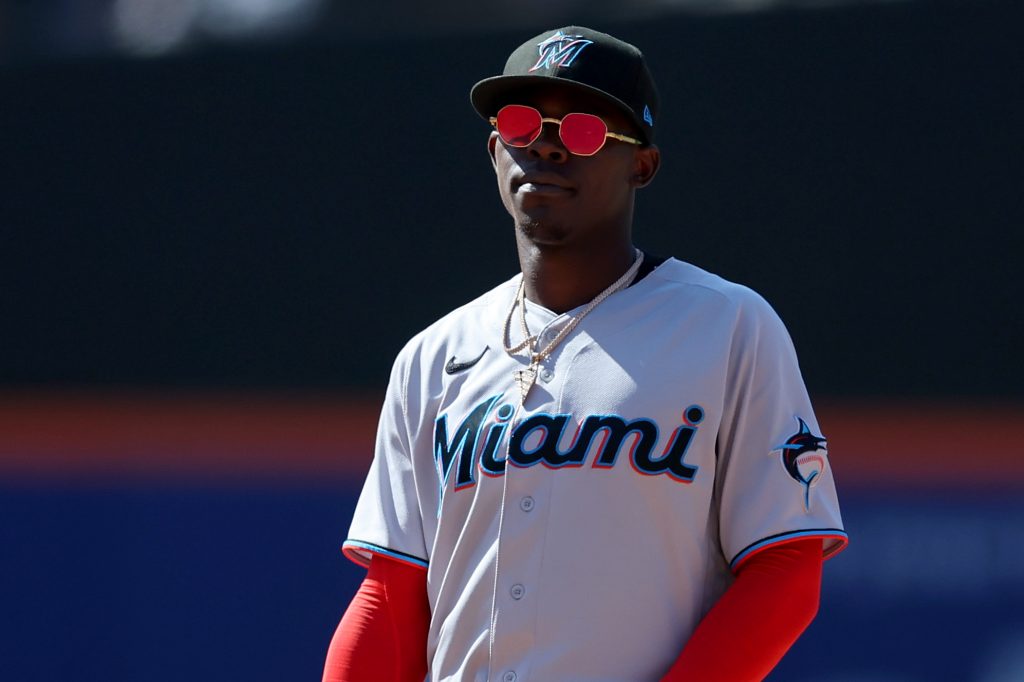The Marlins came into 2023 with a fairly unsettled outfield mix, despite not making any external additions. The club planned to move Jazz Chisholm Jr. off second base in order to take over the center field job that they had been trying to fill for years. Veterans Jorge Soler and Avisaíl García were both coming off disappointing seasons, while a batch of younger player were still looking to establish themselves at the major league level.
Almost one month into the season, the Fish are swimming at a decent pace so far. They are currently 12-12, though with a -37 run differential that suggests they might be a bit lucky to be at that level. Then again, it’s still early and they’ve had a challenging schedule, with all of their games coming against teams that came into the season as surefire contenders or borderline ones (Seven against the Mets, three each against the Twins, Phillies, Diamondbacks, Giants and Guardians, two against Atlanta).
How are their outfielders faring so far? Let’s take a quick look at each one.
Jazz Chisholm Jr.
Chisholm hit .254/.325/.535 in 60 games last year for a wRC+ of 139 before a stress fracture in his back put him on the shelf. He perhaps could have returned late in the year, but the club was out of contention and shut him down, at which point Chisholm underwent surgery on a torn meniscus that he had been playing through.
Whether it’s due to the long layoff, the injuries or the position change, he hasn’t gotten into a groove at the plate yet this year. He’s currently hitting .218/.269/.391 for a wRC+ of 81. He’s struck out in 38.3% of his plate appearances thus far, a jump of more than 10 percentage points from his 27.4% rate last year.
As for that position change, the early reviews are mixed. Defensive Runs Saved has him at -1 so far, with Ultimate Zone Rating at -1.1. On the other hand, Outs Above Average has him at roughly par, 56th percentile. His outfielder jump is in the 84th percentile and his sprint speed is in the 92nd. Some growing pains were surely to be expected since he’s never played the position before, so hopefully these numbers will all trend in a positive direction over time.
Jorge Soler
Soler is perhaps the most mercurial player in the league, having spent the past few years oscillating between being one of the most feared sluggers on the planet and looking lost at the plate. Last year, his first with the Marlins, was a downswing. He struck out in 29.4% of his plate appearances and hit just .207/.295/.400 for a wRC+ of 98, missing significant time due to back spasms. He could have opted out of his contract but chose not to, likely a wise decision with that platform.
Here in 2023, he’s back on another one of his patented heaters. He’s hit five home runs already and has dropped his strikeout rate to a more manageable 23.6%. His .253/.337/.544 line amounts to a 137 wRC+. He’s largely served as the designated hitter but has been given five starts in right.
The torrid stretch for Soler is good for the Marlins in the short-term, but the long-term may be different. Soler has another opt-out opportunity after this season and would likely take it if he can maintain anything close to this pace, as he’d be walking away from just one year and $9MM.
Avisaíl García
García has a similarly inconsistent track record to Soler, posting above-average wRC+ figures in 2017, 2019 and 2021 but dipping below average in the following year each time. Last year was an especially low ebb, as his 28.7% strikeout rate and 4.5% walk rates were both career worsts, as was his 66 wRC+ from his .224/.266/.317 batting line.
Now that we’re in an odd-numbered year, García is scheduled for a bounceback but has actually gotten worse in the early going so far. He’s slashing just .161/.200/.274 for a wRC+ of 30. The .211 batting average on balls in play is due for some regression, but he’s also been punched out 32.8% of the time while drawing walks at just a 3.0% clip. The Marlins desperately need him to turn things around, as his contract pays him $12MM per year through 2025, with a $12MM club option for 2026 that has a hefty $5MM buyout. Barry Jackson and Craig Mish of the Miami Herald reported yesterday that the club haven’t considered releasing him, but a benching is on the table.
Bryan De La Cruz
De La Cruz came into this year with 574 plate appearances. His 24.9% strikeout rate and 6.4% walk rate were both a little worse than average, but he had 18 home runs and a .269/.318/.430 line for a 108 wRC+. He’s a little bit ahead of that pace this year, currently hitting .295/.341/.436 for a 114 wRC+ with fairly similar strikeout and walk rates.
He won’t maintain a .396 batting average on balls in play all year, but he is making solid contact. His average exit velocity is in the 88th percentile of MLB hitters, and his hard-hit rate sits in the 80th percentile. Even without elite plate discipline, he can still be a useful hitter with that kind of bat. The right-hander hitter actually has reverse splits, both in his career and so far this season, which would seem to lessen the likelihood of him ending up in the short side of a platoon.
Jesús Sánchez
The hot start of De La Cruz seems to have cut into the playing time of Sánchez, as he’s been given only 36 plate appearances in 16 games. He’s hit just .172/.333/.241 in that time, which isn’t doing much to get him in the lineup more.
A left-handed hitter, he has traditional platoon splits for his career. He’s hit .226/.310/.440 against righties for a 108 wRC+, but he has a dismal .195/.230/.323 against southpaws for a 49 wRC+. He could seemingly serve as a useful platoon lefty bat but probably won’t get a chance as long as De La Cruz continues to seem like a viable lineup regular. He’s out of options and can’t be sent to the minors without first being exposed to waivers, which might keep him on the bench until an injury opens a spot for him. Per Jackson and Mish, Sanchez is at risk of losing his roster spot, though the club won’t make a decision on that front until Joey Wendle is back from the injured list.
Peyton Burdick
Burdick got to make his major league debut last year and hit .207/.284/.380 for a wRC+ of 91 in 102 plate appearances. He’s been in Triple-A this year and utterly mashing. Through 20 games, he has a line of .309/.385/.654 and a 157 wRC+. He has a 37.4% strikeout rate and won’t sustain a .436 batting average on balls in play, but he’s already hit eight home runs and stolen four bases.
Jerar Encarnación
Encarnación also got a brief major league debut last year, stepping to the plate 81 times but hitting just .182/.210/.338. Like Burdick, he’s also having an excellent start to his 2023 in Triple-A. He has a current batting line of .292/.378/.472 for a wRC+ of 119. However, it’s bolstered by a huge .529 batting average on balls in play and comes despite a 42.7% strikeout rate. His 12.2% walk rate is encouraging but there’s surely some regression coming here.
——
It’s hard to glean definitive judgment from one month’s worth of data, but there are some trends and takeaways in the Miami outfield with nearly 15% of the season in the books. Chisholm’s defense in center has been at least passable thus far, so he’s likely to continue on in that role. De La Cruz could hit his way into an everyday role in left field, but right field looks like a continued problem unless Garcia can correct what’s now more than a full season’s worth of struggles. Sanchez’s grip on a roster spot appears tenuous, but while the primary alternatives in Triple-A (Burdick, Encarnacion) have flashy batting lines, their lack of contact calls into question whether they’d be improvements. It’s easy enough to see the outfield again being a point of focus at the trade deadline, whether the Marlins are looking to add a veteran bat to stay in the Wild Card race or looking to acquire a controllable outfielder as part of another selling effort.

